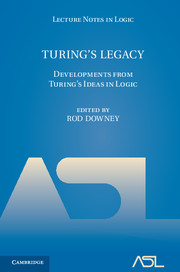Book contents
- Frontmatter
- Contents
- Turing's legacy: developments from Turing's ideas in logic
- Computability and analysis: the legacy of Alan Turing
- Alan Turing and the other theory of computation (expanded)
- Turing in Quantumland
- Computability theory, algorithmic randomness and Turing's anticipation
- Computable model theory
- Towards common-sense reasoning via conditional simulation: legacies of Turing in Artificial Intelligence
- Mathematics in the age of the Turing machine
- Turing and the development of computational complexity
- Turing machines to word problems
- Musings on Turing's Thesis
- Higher generalizations of the Turing Model
- Step by recursive step: Church's analysis of effective calculability
- Turing and the discovery of computability
- Transfinite machine models
- References
Transfinite machine models
Published online by Cambridge University Press: 05 June 2014
- Frontmatter
- Contents
- Turing's legacy: developments from Turing's ideas in logic
- Computability and analysis: the legacy of Alan Turing
- Alan Turing and the other theory of computation (expanded)
- Turing in Quantumland
- Computability theory, algorithmic randomness and Turing's anticipation
- Computable model theory
- Towards common-sense reasoning via conditional simulation: legacies of Turing in Artificial Intelligence
- Mathematics in the age of the Turing machine
- Turing and the development of computational complexity
- Turing machines to word problems
- Musings on Turing's Thesis
- Higher generalizations of the Turing Model
- Step by recursive step: Church's analysis of effective calculability
- Turing and the discovery of computability
- Transfinite machine models
- References
Summary
§1. Introduction. In recent years there has emerged the study of discrete computational models which are allowed to act transfinitely. By ‘discrete’ we mean that the machine models considered are not analogue machines, but compute by means of distinct stages or in units of time. The paradigm of such models is, of course, Turing's original machine model. If we concentrate on this for a moment, the machine is considered to be running a program P perhaps on some natural number input n ∈ ℕ and is calculating P(n). Normally we say this is a successful computation if the machine halts after a finite number of stages and we may read off some designated form of output: ‘P(n)↓’ However if the machine fails to halt after a finite time it may be exhibiting a variety of behaviours on its tape. Mathematically we may ask what happens ‘in the limit’ as the number of stages approaches ω. The machine may of course go haywire, and simply be rewriting a particular cell infinitely often, or else the Read/Write head may go ‘off to infinity’ as it moves inexorably down the tape. These kind of considerations are behind the notion of ‘computation in the limit’ which we consider below.
Or, it may only rewrite finitely often to any cell on the tape, and leave something meaningful behind: an infinite string of 0, Is and thus an element of Cantor space 2ℕ. What kind of elements could be there?
- Type
- Chapter
- Information
- Turing's LegacyDevelopments from Turing's Ideas in Logic, pp. 493 - 529Publisher: Cambridge University PressPrint publication year: 2014
References
- 5
- Cited by

